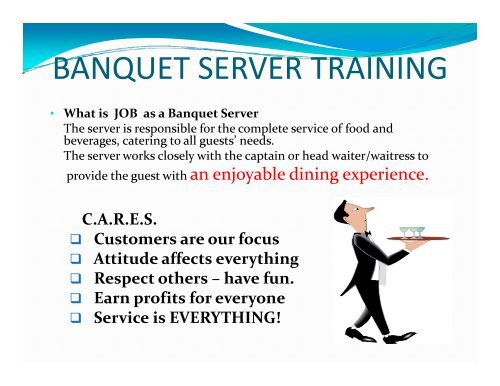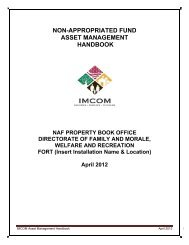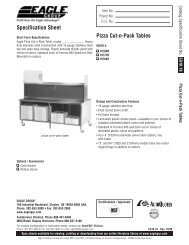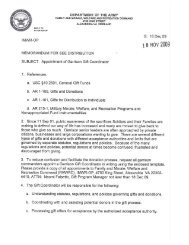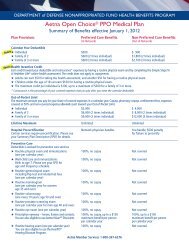BANQUET SERVER TRAINING - ArmyMWR.org
BANQUET SERVER TRAINING - ArmyMWR.org
BANQUET SERVER TRAINING - ArmyMWR.org
Create successful ePaper yourself
Turn your PDF publications into a flip-book with our unique Google optimized e-Paper software.
<strong>BANQUET</strong> <strong>BANQUET</strong> <strong>SERVER</strong> <strong>TRAINING</strong> <strong>TRAINING</strong><br />
• What is JJOB as a Banquet q Server<br />
The server is responsible for the complete service of food and<br />
beverages, catering to all guests’ needs.<br />
The server works closely with the captain or head waiter/waitress to<br />
provide the guest with an enjoyable j bl dining di i experience. i<br />
CARES C.A.R.E.S.<br />
Customers are our focus<br />
Attitude affects everything y g<br />
Respect others –have fun.<br />
Earn profits for everyone<br />
SService i i is EVERYTHING!
BASIC ROLES<br />
Ensure the setting of tables completely according to<br />
diagram and/or sample table.<br />
Serve and clear food and beverage g qquietly, y,<br />
professionally, and quickly, using proper serving and<br />
clearing techniques.<br />
Keep work area clean, and coordinate actions with the<br />
Banquet team members, and all other members of the<br />
front and back of the house to ensure flawless<br />
customer service.<br />
Maintain good g grooming g gand personal p hygiene. yg
Server’s Server s Etiquette<br />
Uniform<br />
White Whi Tuxedo T d Shirt Shi<br />
Black Dress Pants<br />
Black Bow Tie<br />
Black Apron<br />
Black Socks / Natural Colored Hose<br />
Rubber Soled Shoes<br />
Name Tag<br />
Hair Tied Up (if long)<br />
SServiette i tt<br />
Smile<br />
All shirts, pants, and aprons must be<br />
ironed.
Server’s Etiquette ‐ continued ‐<br />
Friendly Service<br />
• Remember that g guests can see y you whenever y you are in the room<br />
–be be courteous, efficient, and quiet.<br />
• Maintain good posture –and and never slouch, lean, or slump<br />
• While in the room, smile and, when appropriate, acknowledge guests<br />
through h h b brief if eye contact.<br />
• All associates shall remain on the floor while guests are around.<br />
• Each server should constantly monitor his/her station, refilling water<br />
glasses, and serving fresh coffee or tea.<br />
Handling Requests<br />
• D Do D not neglect l a guest request j just j because b the h guest is i not in i your area.<br />
If he/she makes a request directly to you, take care of it personally and<br />
quickly, if possible.
Server’s Etiquette ‐ continued ‐<br />
R Rules l f for R Resolving l i C Complaints l i<br />
1. Listen and Empathize<br />
Listening is the most important component of the communication process.<br />
Having empathy is being aware of and sensitive to the emotions of others<br />
‐ “I think I know how you feel.”<br />
‐ “I understand what is upsetting you and I am glad you told me”.<br />
2. Apologize p g and Commit to Solving g the Problem Problem. .<br />
Accept responsibility for the problem’s resolution.<br />
If you are unable to do so, bring in to the attention of the captain or manager. If the<br />
complaints regards a meal, remove the plate and replace it.<br />
3 3. Identify Identify a a Mutually Mutually Acceptable Acceptable Solution<br />
Solution<br />
4. Check Back and Follow Up<br />
When the Guest Leaves the table<br />
• Take napkin and fold it neatly<br />
Take napkin and fold it neatly<br />
• Set napkin back on table.<br />
• Attend tte d to to t the epacesett place setting g as as needed eeded<br />
• Reposition the chair
Team Team System of Service<br />
- To increase all aspects of service to the guests.<br />
Back Position:<br />
Support the front<br />
partner<br />
running food items<br />
from the back aisle to<br />
the station, responding<br />
to special guest requests<br />
f from th the ffront t partner, t<br />
and anticipating the<br />
next need of the front<br />
partner.<br />
Front Position:<br />
Be on the floor most of<br />
time i to serve guests<br />
handling actual food<br />
delivery to each guest<br />
and taking special<br />
requests which he/she<br />
th then passes on to t th the<br />
back position server.
COMMUNICATION COMMUNICATION STANDARDS<br />
Controlling Service in the Room<br />
Floor supervisor control service<br />
When serving<br />
When clearing<br />
Begin and end<br />
Communication with the Kitchen<br />
Head Count<br />
A Any last l t minute i t requests t<br />
Any anticipated problems that my arise<br />
Communication with Guests “10 and 5” Rule<br />
Communication with Guests ‐ 10 and 5 Rule<br />
This rule is about the zone between customer and employee in<br />
terms of hospitality good customer service.<br />
‐ Smile, make eye contact with a customer at 10 foot range<br />
‐ Smile, greet them, and offer assistance within a 5‐foot range
PRE‐MEAL PRE MEAL BRIEFING<br />
• Making the Most of the Most Important 15 Minutes<br />
A pre‐meal briefing is required before all meal<br />
functions functions. It is to be conducted by the floor supervisor<br />
in charge of the event. Station assignments are given<br />
out after the agenda is covered.<br />
Inspect : To insure the staff ready for the function<br />
Inform : Communicate accurate information;<br />
Standard Agenda / Station Assignment<br />
Motivate : T To h have a Positive & Productive shift
PRE‐ EVENT PREPARATION GUIDELINES<br />
Make sure that linens are clean and pressed<br />
–no rips, fading or burns.<br />
Confirm with your Captain / Head Waitress<br />
exactly what place place‐settings settings are required for<br />
each event.<br />
Fold napkins neatly according to the design<br />
selected by the Captain / Head Waitress<br />
or th the event t representative. tti<br />
Confirm that all utensils needed for each<br />
course are included at each place setting<br />
Inspect p all dishes and glassware g for spots p or<br />
blemishes<br />
Make sure all wicker baskets are free of<br />
fraying and crumbs.<br />
Be at your post post, in uniform and ready to work<br />
at least 15 minutes before any event is scheduled<br />
to begin.<br />
Complete all service setup and ensure the<br />
doors can be opened before the event starts
Cloths for all table arrangements<br />
TABLE TABLE CLOTHES<br />
1. Should be clean and free from rips and burn holes.<br />
2. Should be pressed (small wrinkles may be smoothed out with palm of hand;<br />
excessive wrinkles must be pressed with an iron or steamer).<br />
3. Creases should be “centered” following the same directional principle in which<br />
the tables for the function were positioned.<br />
4. Cloths should not fall below the seats of the guests’ chairs, but should be<br />
tangent to (i.e., (i e just touching) the top of each chairs’ chairs seat seat.<br />
5. “Turned under” side of the hemline should be facing the table.<br />
Round Tables<br />
1. Cloths should be “centered” on the tables so there is an equal drop on all sides.<br />
2. Center fold line should run from north to south (head of the room is always<br />
considered north) with corners of the cloth dropping directly over table legs,<br />
depending on where head table is.
Basic Table Setting Method<br />
a. Assembly Line Technique<br />
- One server sets one particular item at a time on all the tables<br />
(e.g., all forks, all knives, etc.)<br />
b. Station Set<br />
- One server (or team) is responsible for setting all the items<br />
on his/her(their) particular station. With this method, well<br />
<strong>org</strong>anized and combined efforts increase efficiency and<br />
decrease setup time.<br />
Table/station assignments can be made prior to the premeal<br />
briefing with any additional questions/details<br />
regarding assignments discussed during the briefing briefing.
TABLE SET‐UP<br />
The first plate or place setting must always be set in the 12 o’clock chair –<br />
the one that faces the north wall.<br />
Chairs must be lightly touching tablecloth.<br />
Two sugar caddies dd and d two creamers on each h table. bl<br />
Two sets of salt and pepper shakers completely filled on each table.<br />
The first plate (or place setting) should always be set the center.<br />
The remainders are evenly spaced from there.
PLACE C SSETTING GREMINDERSS Napkin in ½ inch from table.<br />
Knife blade faces inward.<br />
Spoon and Knife handles are even.<br />
Entrée fork is even with top of knife.<br />
Salad fork ¼ inch lower than entrée fork.<br />
Appetizer fork ¼ lower than salad fork (if served 5 course)<br />
Dessert fork above napkin, handle facing left.<br />
Intermezzo spoon above dessert fork with handle facing right. (4 and 5 course<br />
only)<br />
Coffee sauce placed near edge of table.<br />
Coffee cup handle at 4 o’clock position.<br />
Water glass directly above tip of knife.<br />
Champagne glass at 11 o’clock to water glass<br />
Wine glass at 5 o’clock to water glass<br />
Bread and Butter (B&B) plate above forks.<br />
B&B knife handle to the right.
STANDARD TABLE SETTING for<br />
Bread and Butter (B&B) plate above forks<br />
Bread & Butter<br />
Entrée Fork<br />
BREAKFAST<br />
10 – 11”<br />
Napkin<br />
½” from the edge<br />
Water<br />
½” ½<br />
WWater t glass l directly di tl above b ti tip of f kknife. if<br />
Juice<br />
The flatware must be placed no closer than ½” from the edge of the table.<br />
CCoffee ff C Cup &<br />
Saucer
STANDARD TABLE SETTING for<br />
LUNCHEON<br />
Bread and Butter (B&B) plate above forks.<br />
Bread B d & Butter B tt<br />
Dessert fork and coffee spoon are always at the top of the place setting.<br />
Coffee Spoon on top.<br />
Water glass directly above tip of knife.<br />
Salad<br />
Salad fork ¼ inch lower<br />
than entrée fork.<br />
Entree<br />
½” ½<br />
Dessert<br />
Water<br />
Wine<br />
Wine glass at 5 o’clock<br />
10 – 11” to water glass<br />
Napkin<br />
½” from the edge<br />
Entree<br />
Salad<br />
Soup<br />
The flatware must be placed no closer than ½” from the edge of the table.<br />
Coffee Cup &<br />
Saucer
Bread and Butter (B&B) plate above forks.<br />
Salad<br />
STANDARD TABLE SETTING for<br />
Bread & Butter<br />
Entree<br />
FORMAL DINNER<br />
Dessert fork and coffee spoon are always at the top of the place setting.<br />
Coffee Spoon on top.<br />
Dessert<br />
10 – 11” 11<br />
Appetizer<br />
Napkin<br />
Appetizer fork ¼” lower<br />
than salad fork.<br />
fork<br />
Water<br />
WWater t glass l directly di tl above b ti tip of f kknife if<br />
Red Wine<br />
White Wine<br />
Wine glass at 5 o’clock<br />
to water glass<br />
½” from the edge<br />
SSalad ffork ¼ “ lower<br />
than entrée fork.<br />
Entree<br />
Salad Soup Coffee Cup &<br />
Saucer
NAPKIN NAPKIN HOLDING<br />
A special table says that you really value your guests<br />
when you make the extra effort to set the table<br />
beautifully beautifully.<br />
The Pyramid Napkin Fold<br />
The Standing Fan Napkin Fold<br />
The Bishop's Hat Napkin Fold<br />
Th The CCandle dl NNapkin ki FFold ld<br />
The Rosebud Napkin Fold<br />
The Crown Napkin Fold
The Pyramid Napkin Fold<br />
This classy napkin folding technique is simple, fast, and can be made easily with most napkins. If the napkin<br />
bi being used d iis thi thin and d fl flops easily il th then iiron it with ith li light ht starch t hprior i tto ffolding ldi and d it will ill tturn out t perfectly! f tl !<br />
Fold Napkin in<br />
Fold<br />
Half<br />
Corner to<br />
Diagonally Diagonally. Meet top<br />
Point.<br />
Turn<br />
Napkin<br />
Over and<br />
Fold in<br />
Half.<br />
Pick up at<br />
Center and<br />
Stand on<br />
Base of<br />
Triangle.
Fold<br />
napkin ki in i<br />
half.<br />
The Standing Fan Napkin Fold<br />
Elegant and decorative, this is a classic napkin folding technique. As usual, and iron helps but is<br />
not not necessary necessary.<br />
Starting Fold up in<br />
bbottom, tt<br />
half with<br />
accordion pleating on<br />
pleat 2/3 the<br />
way y up. p outside outside.<br />
Fold upper<br />
right ihtcorner<br />
diagonally<br />
down to<br />
folded base of<br />
pleats and<br />
turn under<br />
edge.<br />
Place on table<br />
and release<br />
pleats to form<br />
fan.
Fold<br />
napkin in<br />
half<br />
making a<br />
rectangle.<br />
The Bishop's Hat Napkin Fold<br />
This is a classic dinner napkin fold, but it can be difficult to line up the corners in the cap. Some<br />
starch starch and an iron make it easier to be precise while folding this one.<br />
Fold corners<br />
to create a<br />
parallelogram.<br />
Turn napkin k<br />
over<br />
lengthwise.<br />
Fold up p<br />
from<br />
bottom onto<br />
itself; pull<br />
right ihtti tip<br />
down from<br />
under.<br />
Bring corners<br />
together<br />
tucking one<br />
into the<br />
other.<br />
Open base of<br />
fold and stand<br />
upright.
Fold napkin Fold up<br />
in half<br />
base<br />
diagonally 1/3 way way.<br />
The Candle Napkin Fold<br />
So you want something easy and elegant? Something that looks nice and fancy but doesn't<br />
take a boat‐load of time? Try this one on for size.<br />
Turn napkin<br />
over and roll<br />
from bottom<br />
Tuck corners<br />
inside cuff at<br />
base of fold<br />
to top and stand. base.<br />
Turn one layer<br />
of point down<br />
and set on<br />
b
Fold napkin in<br />
half<br />
diagonally<br />
The Rosebud Napkin Fold<br />
This sophisticated cloth napkin design benefits from stiff material or light starch. A hot iron will<br />
also make it easier to be exact.<br />
Fold corners to Turn napkin<br />
meet at top p over and fold<br />
point bottom 2/3<br />
way up.<br />
Turn napkin<br />
around and<br />
bring corners<br />
together,<br />
tucking one into<br />
the other.<br />
Turn napkin<br />
around and<br />
stand on<br />
base
Lay the napkin<br />
face‐down in<br />
front of you.<br />
The Crown Napkin Fold<br />
Do you want your dinner guests to feel like royalty but have no red carpet? Treat them like<br />
kings and give them all crowns! Then you can use this napkin to wipe the cheese out of that<br />
iintroduction. t d ti<br />
This napkin folding design just doesn't work well without a little starch in the cloth, if it's<br />
sagging it's ugly so take your time and get it right.<br />
FFold ldthe h napkin ki Oi Orient the h FFold ldthe h right‐ ih RRepeat step four f on<br />
in half diagonally. napkin so the corner up so that the other side,<br />
open ends are the point rests bringing the left‐<br />
pointing away directly on top of most corner up to<br />
from you. y<br />
the middle‐corner. meet the middle‐<br />
The edge of this corner, creating a<br />
new flap should lay<br />
on the center line<br />
of the napkin.<br />
diamond shape.
The Crown Napkin Fold<br />
‐ Continued<br />
Fold the bottom of the<br />
napkin up about 2/4 2/4'ss<br />
of the way and press<br />
this fold down well.<br />
Fold the smaller<br />
ti triangle l ddown<br />
so<br />
the point rests on<br />
the near edge of<br />
the napkin. Press.<br />
curl the left and right<br />
sides id of f th the napkin ki<br />
up so they meet in<br />
the middle and tuck<br />
one into the other.<br />
Stand it up and tug at it where<br />
needed ddtto even it up and d<br />
round it out. If your napkins<br />
are too limp then think of<br />
starch as napkin viagra and<br />
make them good and stiff.
TRAY TRAY STANDARDS<br />
CARRYING CARRYING TRAYS<br />
• OVAL<br />
»» Carry over your left shoulder<br />
»» 1 hand under the heaviest part<br />
»» Fingers pointed to the back of the tray<br />
»» Do not carry in front, at waist level<br />
»» Keep your other hand free to balance the tray tray, open doors doors, carry the<br />
tray stand, etc<br />
• 16” ROUND<br />
»» Use as directed for mixed drinks, individual beverage orders, etc.<br />
»» Carry on the left for ease, in front of your body<br />
Tray jacks should only<br />
be placed around the<br />
perimeter of the room.
TRAY HANDLING GUIDELINES<br />
Trays require special care to avoid accidents. Follow these<br />
guidelines guidelines.<br />
LOADING TRAYS<br />
»» Never load more than you can carry –2 trips are better than 1 accident<br />
»» Before loading, check that the tray is clean and dry<br />
»» Place heavier items at center of the tray or on the side closest to your body<br />
»» Lay tall glassware down and away from the edge of the tray<br />
»» Lay condiment bottles flat on the tray<br />
»» Fit plate covers properly before carefully stacking on the tray<br />
SERVING FROM TRAYS<br />
Always use a tray stand with oval trays<br />
Open p stand, bend at the knees, ggently y slide the tray y onto center of the stand<br />
Never place tray on chair<br />
CLEARING DISHES ON THE TRAYS<br />
When removing soiled plates, the remaining food should never be scraped<br />
Onto the banquet tray. Instead, place two plates’ side‐by‐side and then<br />
Slide the food onto one plate. This will leave one plate with all the food on it,<br />
Never overload trays. Stack heavier<br />
items at the center of the tray.<br />
And one stack of plates with no food or debris. Carry oval trays over<br />
Do this with your back to the guests, as quietly as possible.<br />
No noise should be heard.<br />
your left shoulder, with one hand<br />
under the heaviest part.
TABLESIDE SERVICE STANDARDS:<br />
1. Serving a Whole Table<br />
a. Ladies before gentlemen<br />
b. Old before young young<br />
c. Food is served to guest’s left side, and beverage is served<br />
from the guest’s right side. Clearing dishes is from the guest’s right side.<br />
d. Walk Forward : After serving someone, walk forward –<br />
in the direction you are facing.<br />
Walk clockwise while<br />
Serving g beverages g and clearing. g<br />
Walk counter-clockwise while serving the guest.
Always serve food from the left<br />
of the guest.<br />
Hold all dishes by the rim of the plate.<br />
Keep your fingers away from the food.<br />
Always serve drinks from<br />
the right of the guest.<br />
Keep cups and glasses<br />
on the table when refilling them.<br />
Always clear items onto an oval tray.<br />
Clear food and beverages from the guest’s<br />
right.
TABLESIDE SERVICE<br />
Bread Service : lunch = bread basket ,<br />
dinner = the first bread serve by the server<br />
Soup Service : using a tureen with a ladle<br />
Salad Service : non‐composed / composed salad<br />
Serving Sauces : to be passed by the server<br />
Dessert and Coffee Service : coffee must be served,<br />
followed by dessert.<br />
Passing Hors D’oeuvres : carry the plate, platter or tray in<br />
white gloved g hands, and offer ff a beverage‐ g napkin p to the guest. g
Types of Food Service<br />
Plate or American Service<br />
Most common form of banquet service<br />
Food prepared in kitchen and presented on guests’<br />
plates<br />
Russian Service<br />
Food prepared in kitchen<br />
Served from platters onto guests’ plates<br />
(continue<br />
d)<br />
30
Types Types of Food Service<br />
French Service<br />
(continue<br />
d)<br />
Food prepared tableside on carts or a gueridon<br />
Requires space between tables for carts<br />
Preset Service<br />
First course on tables when guests g arrive<br />
Buffet service<br />
Guests serve themselves from arrayed choices<br />
À la Carte Catering<br />
Guests have choice of entrées<br />
31
AMERICAN STYLE<br />
STYLES STYLES of SERVICE<br />
Plated Service: Food is plated in the kitchen and served to guests.<br />
A la Carte Service : off the menu service. Guests are provided a menu as<br />
they are seated. Due to the time and cost constraints, the appetizer, salad<br />
and dessert are pre pre‐selected selected for all guests guests.<br />
Buffet Style Service : walk through the buffet as a guest would to help to<br />
fine tune the placement of items and ensure maximum accessibility and<br />
convenience.<br />
FAMILY –STYLE SERVICE<br />
The guests basically serve themselves after receiving platters of food that<br />
are passed p down the table.<br />
FRENCH SYTLE<br />
The use of elegant serving pieces; the heating and garnishing of food at<br />
table side by y a Captain…. p<br />
Very impressive, but requires ample space.
STYLES of SERVICE ‐continued‐<br />
RUSSIAN STYLE<br />
The food is fully prepared and pre‐cut in the kitchen. All courses are served either<br />
from platters or from a special dish called an “Escoffier” dish. Tureens are used for<br />
soup and special bowls for salad. The rule for Russian service is to place empty<br />
plates from the right, by going around the table clockwise. Food is served from a<br />
platter from the left of the guest, continuous service going around the table count‐<br />
clockwise. Clear from the right, moving count‐clockwise.<br />
BUTLER STYLE<br />
This service is similar to Russian Service. The difference is the guest g helps p him or<br />
herself from the tray which the server holds. This requires additional portioning, in<br />
case the guests take more than their share.<br />
ENGLISH STYLE<br />
This service is similar to Russian Service and to family‐style service. Food is brought<br />
to the table on a tray, or bowls, presented to the host, who either cuts the food<br />
him/herself / of chooses to have it done by y the server, , away y from the table. A good g<br />
example is a whole turkey or roast beef.
EXAMPLE OF SEQUENCE OF SERVICE OF DINNER SERVICE<br />
1. First course’s food is served to guest’s left side.<br />
2. The first course food plate and silver is cleared from the guest’s right side with the<br />
right hand.<br />
3. 3 The first course wine is cleared from the guest guest’s s right side; leave on table if guest<br />
4.<br />
requests.<br />
Second course’s wine is served from the guest’s right side.<br />
5. Second course’s food is served from the guest’s left side.<br />
66. The second course food plate and silver is cleared from the guest’s guest s right side side.<br />
7. The second course wine is cleared from the guest’s right side; leave on the table if<br />
guest requests. (Repeat)<br />
8. Entrée is served from the guest’s left side.<br />
99. Entrée is cleared from the guest’s guest s right side side.<br />
10. Entrée wine is cleared from the guest’s right side.<br />
11. Bread and butter plates and knives are cleared from the guest’s left side as each<br />
guest’s entrée plate is cleared.<br />
12 12. Butter/margarine Butter/margarine, salt and pepper are cleared cleared.<br />
13. Cream and sugar are served.<br />
14. Coffee cup and saucer is served from the guest’s right side.<br />
15. Coffee is served from the guest’s right side.<br />
16 16. Dessert is served from the guest’s guest s leftside left side.<br />
17. Dessert is cleared from the guest’s right side.<br />
18. Guests are thanked for coming as they leave.<br />
19. Final clear.
GENERAL <strong>BANQUET</strong> SERVICE GUIDELINES<br />
1. Tray jacks should only be placed around the perimeter of the room<br />
2. Remove all trays from the room before the meal begins; do not return them until<br />
clearing is required or meal service has ended.<br />
3. Remain on the floor while guests are eating<br />
44. OOnly l lleave th the fl floor tto remove di dirty t items it or pick ikup food f d& & beverage b items. it<br />
5. When in the room, keep quietly focused on diners –do not huddle or chat with fellow<br />
servers.<br />
6. Constantly monitor the carpet for items that need pickup and removal<br />
77. Carry no more than 3 entrees at a time from the service stand to the table<br />
8. Warn guests when serving hot plates, beverages, etc.<br />
9. Handle all items as quietly as possible around guests (and try to keep noise to a<br />
minimum in areas adjacent to the dining room.
THE “DON’Ts of<br />
<strong>BANQUET</strong> SERVICE<br />
Don’t place a napkin under your arm.<br />
Don’t wipe your face or your mouth with<br />
your side towel.<br />
Don’t use the guest entrance during a<br />
function<br />
Don’t stand in a large group congregating<br />
during a function<br />
Don’t eat or drink anything in front of the<br />
guests.<br />
Don’t eat anything while servicing the<br />
guests.<br />
Don’t stand around with your hands in your<br />
pockets or your arms crossed<br />
Don’t pick up glasses by the tops<br />
Don’t go to break all together<br />
Don’t chew a gum g during g<br />
a function
CLEANILINESS CLEANILINESS AND SANITATION<br />
Daily Cleaning g Checklist<br />
Banquet Linen Checklist<br />
Banquet Equipment Care Checklist<br />
Skirting<br />
Silver Chafers<br />
Mirrors<br />
Candles<br />
Coffee Break Urns<br />
Number Stands & Numbers<br />
Salt & Pepper Shakers and Sugar Bowls<br />
Side Work Assignment : pre pre‐function function / post post‐function<br />
function
BEVERAGE BEVERAGE SERVICE STANDARD<br />
QQuality yCustomer<br />
Service in the Bar area<br />
Great Attitude<br />
A good attitude and a pleasant personality<br />
Service Skills<br />
Art of taking an order, delivering the product and presenting<br />
the check.<br />
Sales Skills<br />
Proper service skills and the ability to interact with customers<br />
Up‐selling ll skills kll<br />
Product Knowledge<br />
Different flavors and good descriptive elements of the products
BEVERAGE SERVICE STANDARD ‐continued‐<br />
Mixology<br />
Need to know the beverage g recipes p<br />
Ingredients, portion size, glassware, mixing technique,<br />
garnishes<br />
Draft Beer<br />
Proper techniques and knowledge to serve draft beer effectively<br />
and efficiently.<br />
Presentation<br />
“You eat with your eyes”<br />
Setting the Stage<br />
Setting the atmosphere or ambiance of the bar<br />
Lights, music, ashtrays, snacks, televisions etc.
Hosted Bars<br />
TYPE OF BAR SERVICE<br />
All beverages consumption charges to the client’s master<br />
account<br />
O Open Bars B<br />
Limited number of people and limited time period.<br />
Charges to the client’s client s master account<br />
Cash Bars<br />
Self Self‐Service Service Bars<br />
Relative to the Hosted Bar Service without a bartender<br />
Suggested only o ybee beer, , wine, e, soda, and a d mineral ea waters ate s
THANK YOU


